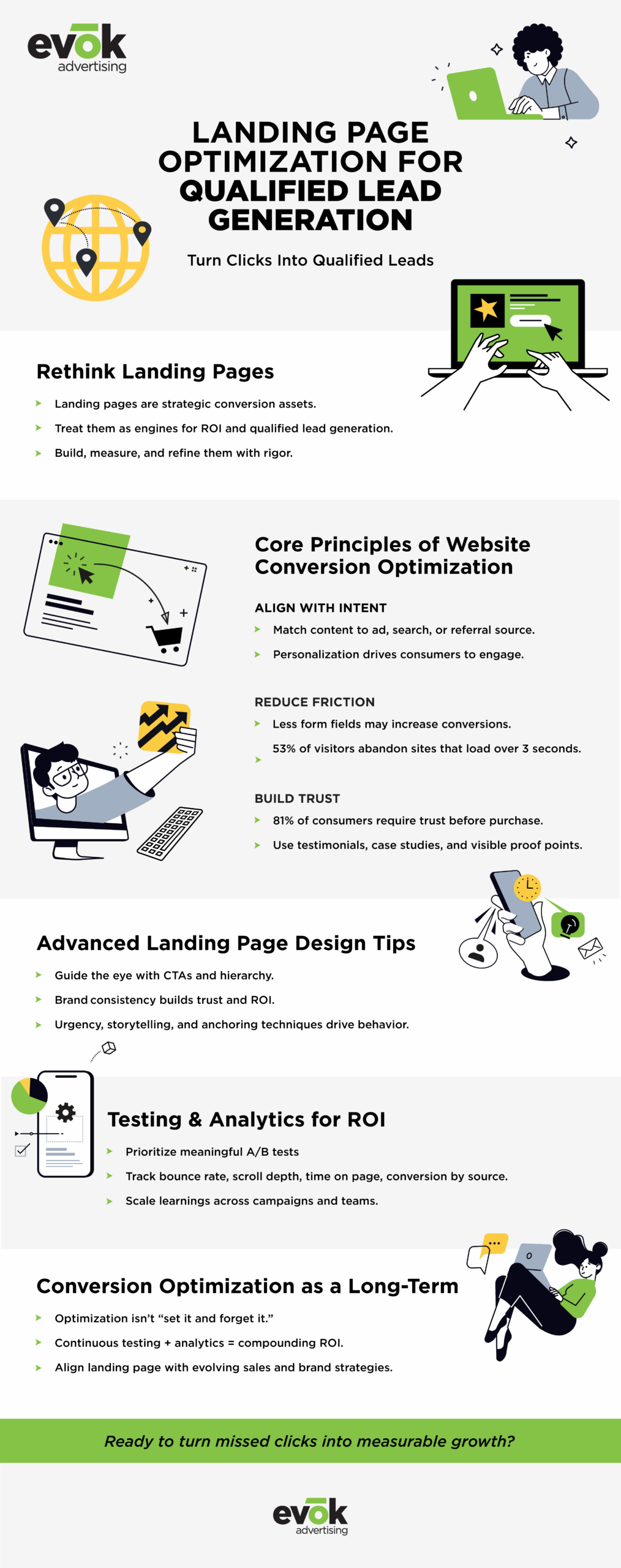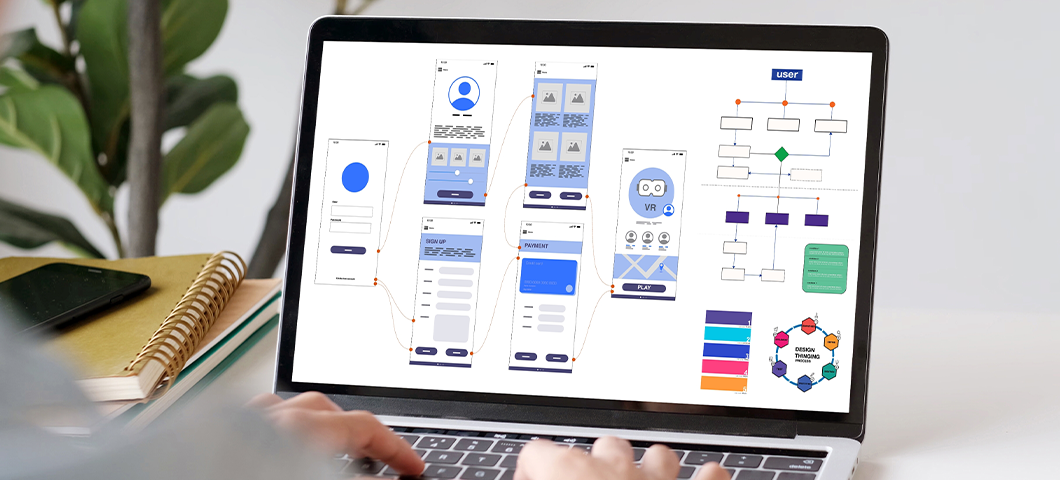
Landing Page Optimization: How to Turn More Website Visitors into Qualified Leads
Every click that lands on your website is a chance to win—or lose—a future customer. Yet too many landing pages stop short of their true potential, functioning as digital brochures instead of conversion engines. For CMOs balancing budgets, growth targets, and ROI accountability, that’s wasted opportunity hiding in plain sight.
Landing page optimization isn’t about cosmetic tweaks. It’s about architecting experiences that anticipate user intent, guide action with precision, and pre-qualify leads before they hit your sales pipeline. The brands that excel at this don’t just improve conversion rates; they build a repeatable framework for qualified lead generation that scales with every campaign.
At evok, we approach landing pages as strategic assets, not static pages. In this blog, we’ll dive into advanced landing page optimization strategies that go beyond best practices, showing how the right design, analytics, and testing can transform casual visitors into your most valuable leads—and give you the kind of ROI your board wants to see.

Rethinking Landing Pages as Strategic Conversion Assets
Landing pages are often treated as campaign afterthoughts—something built quickly to support an ad or email push. But when viewed through the lens of website conversion optimization, they become one of the most powerful assets in a CMO’s toolkit. The distinction lies in approach: is your landing page simply a static destination, or is it an engineered system designed to drive measurable business outcomes?
For CMOs accountable to both pipeline quality and marketing ROI, this difference is critical. A high-converting landing page doesn’t exist in isolation. It functions as a strategic link in the marketing funnel, connecting awareness-driving channels to qualified lead generation. Rather than thinking of these pages as one-off designs, they should be built and optimized with the same rigor as product launches—grounded in data, guided by user behavior, and continually refined to maximize lead conversion rates.
This shift in perspective also reframes what success looks like. Traditional landing page best practices—clear CTAs, compelling headlines, and mobile-friendly layouts—are necessary but not sufficient. To optimize your landing page for qualified leads, CMOs must push further, leveraging performance metrics, behavioral insights, and testing frameworks to uncover where visitors drop off, why they hesitate, and what ultimately compels them to act.
Core Principles of Website Conversion Optimization

Before diving into design hacks or testing strategies, it’s essential to ground landing page optimization in the fundamentals of website conversion optimization. For CMOs, this means aligning page strategy with business objectives, ensuring every element contributes to lead quality and measurable ROI. The following principles provide the foundation for building high-converting landing pages that consistently transform website visitors into qualified leads.
Aligning Messaging With Audience Intent
Every visitor arrives with context—whether from a paid search ad, social campaign, or organic search. If the landing page doesn’t mirror that intent, conversion rates suffer. Messaging should create a seamless narrative from the click to the page, reinforcing what was promised and why the visitor should take action now.
Advanced marketers are increasingly leveraging dynamic content personalization to tailor messaging, offers, and imagery to reflect a visitor’s referral source, location, or past behavior. In fact, 80% of consumers are more likely to make a purchase when brands offer personalized experiences. Personalization not only improves conversion rates but also increases the likelihood of capturing qualified leads since the page speaks directly to a visitor’s stage in the decision journey.
Reducing Friction in the Conversion Path
The fastest way to lose a lead is through friction—extra steps, unnecessary fields, or slow page load times. Yet reducing friction isn’t about stripping pages down to the bare minimum. It’s about striking a balance between ease of use and lead qualification.
For example, studies show that reducing form fields from 11 to 4 can result in a 120% increase in conversions. Meanwhile, Google reports that 53% of mobile site visits are abandoned if a page takes longer than three seconds to load. For CMOs, this means testing form lengths, CTA placements, and site performance isn’t optional—it’s a baseline requirement for improving conversion outcomes.
Beyond forms, factors like page speed, mobile responsiveness, and intuitive navigation are now baseline requirements. With Google prioritizing site performance in search rankings, these aren’t simply user experience issues—they directly impact both visibility and conversion outcomes.
Building Trust and Authority Instantly
Landing pages have seconds to establish credibility. Without trust, even the best offers stall. For CMOs, this is where brand positioning and conversion science intersect.
Trust signals should be embedded throughout the page—customer testimonials, recognizable client logos, data-backed proof points, and security badges all reduce hesitation. More advanced tactics include integrating case studies or interactive proof points that show tangible results rather than generic claims.
The goal isn’t just to get a form fill—it’s to ensure that form fill belongs to a lead genuinely interested in engaging further. By blending social proof with strong, evidence-based messaging, landing pages act as both a filter and an attractor, improving both conversion rates and lead quality.
Advanced Landing Page Design Tips for Lead Generation

Once the fundamentals are in place, design becomes the lever that can significantly increase landing page conversions. But for CMOs, this isn’t about chasing trends or aesthetics. It’s about engineering pages that influence decision-making, reinforce brand authority, and qualify leads effectively. Below are design strategies that elevate landing pages from functional to transformational.
Designing for Decision-Making, Not Just Attention
Attention is cheap, and decision-making is where conversion happens. High-performing landing pages are structured to guide the eye, reduce cognitive load, and focus visitors on a single, clear action.
Research from heatmaps and eye-tracking studies shows that visitors scan in predictable patterns. Strategic placement of headlines, benefit-driven copy, and CTAs ensures those patterns lead to action. For example, testing whether a CTA performs better above the fold or after a detailed proof point can reveal how your audience prefers to make decisions. For CMOs, these insights aren’t tactical tweaks—they’re scalable learnings that improve website lead generation across multiple campaigns.
Balancing Brand Experience With Conversion Science
A high-converting landing page doesn’t sacrifice brand for performance—it integrates both. Too often, landing pages built purely for conversion feel disconnected from the brand experience, creating a drop-off in trust and long-term engagement.
Effective design aligns visual identity, tone, and value proposition with performance-driven structure. This means consistent use of brand colors and typography alongside optimized layouts that prioritize clarity and action. When design and conversion science are integrated, landing pages don’t just generate leads—they generate leads predisposed to trust your brand and convert at higher rates downstream.
Leveraging Psychology in Landing Page Design
Conversion isn’t purely logical; it’s psychological. The most effective landing pages employ tested behavioral principles to influence action without using gimmicks.
- Anchoring: Presenting a higher-value offer first makes the core offer feel more accessible.
- Urgency and Scarcity: Limited-time offers or capped availability drive faster decision-making.
- Storytelling Frameworks: Framing a landing page like a narrative—problem, solution, outcome—guides visitors through an emotional journey that ends in action.
For CMOs, applying these psychological levers at scale transforms landing pages from static lead capture forms into persuasive conversion ecosystems. Used responsibly, these techniques not only boost lead generation landing pages but also strengthen the quality of those leads.
Testing and Analytics: Turning Insights Into ROI

Even the best-designed landing page is only a hypothesis until it’s tested. For CMOs, the key isn’t just building high-performing pages but creating a framework for conversion rate optimization that continuously improves outcomes and proves ROI. By integrating structured testing and robust analytics, landing pages evolve from static assets into engines of measurable growth.
A/B Testing Landing Pages With Purpose
A/B testing is one of the most effective ways to refine landing page performance—but only when applied strategically. Too often, organizations waste time testing variables with negligible impact. CMOs should prioritize tests that tie directly to business outcomes, such as:
- Headlines and value propositions (clarity vs. creativity)
- CTA placement and language
- Form length and structure (single-step vs. multi-step)
- Visual hierarchy of proof points (social proof before or after the offer)
The goal is not to chase marginal gains but to identify scalable patterns that can optimize landing pages for leads across campaigns. Ensuring statistical significance in tests and documenting results creates an internal playbook for future landing page conversion strategies.
Leveraging Landing Page Analytics for Continuous Improvement
Analytics bridge the gap between guesswork and growth. Beyond basic metrics like clicks and form submissions, CMOs should be tracking deeper landing page performance metrics to understand visitor behavior and identify barriers to conversion.
Key metrics include:
- Bounce rate – Do visitors stay long enough to engage?
- Scroll depth – Are they seeing the CTA or dropping off mid-page?
- Time on page – Is the content engaging or overwhelming?
- Conversion rate by traffic source – Which campaigns deliver the most qualified lead generation?
Advanced analytics platforms also allow for cohort analysis, visitor heatmaps, and session recordings, offering a clear picture of how prospects interact with each element of the page. These insights guide more informed optimization decisions and uncover opportunities to improve website visitor conversion.
From Data to Action: Scaling Learnings Across Campaigns
Testing and analytics aren’t just about improving a single page—they’re about building a culture of landing page ROI optimization. The insights gained should inform broader campaign strategies, from messaging frameworks to audience segmentation.
For CMOs, this means creating feedback loops where data from landing page tests shapes future creative, targeting, and even product positioning. In practice, that might look like identifying which benefits resonate most strongly with high-value leads, then amplifying those benefits across paid, organic, and email campaigns.
As a digital-focused marketing agency, we treat testing and analytics as the heartbeat of landing page optimization. By transforming raw data into actionable insights, CMOs not only increase landing page conversions but also elevate the entire marketing ecosystem, driving sustainable growth and measurable ROI.
Conversion Rate Optimization as a Long-Term Strategy

Landing page success isn’t measured in quick wins—it’s measured in sustained, scalable growth. For CMOs, the real value of website conversion optimization comes from treating it as an ongoing discipline rather than a one-time project. Small improvements accumulate, creating compounding gains in lead quality and revenue impact over time.
Too often, organizations fall into the trap of “set it and forget it.” A landing page performs well at launch, and optimization stops. But audiences shift, competitors evolve, and what worked six months ago may underperform today. The most effective marketing leaders adopt a continuous improvement model, where landing page analytics and testing cycles are built into campaign planning from the outset.
This approach also ensures alignment with larger business goals. For example:
- As the sales team adjusts qualification criteria, landing page forms can be refined to capture more predictive data.
- When brand positioning evolves, messaging and creative can be optimized to reflect new value propositions.
- As budgets increase, A/B testing landing pages at scale can uncover insights that inform the entire marketing funnel.
By weaving optimization into the DNA of their marketing strategy, CMOs create a resilient growth engine. Landing pages don’t just capture leads—they continuously improve website conversion rates and deliver predictable ROI, quarter after quarter.
At evok, we build these long-term frameworks with our clients. From initial design to ongoing A/B testing, we treat landing pages as living assets that evolve with your business and your audience. The outcome isn’t just more conversions—it’s a reliable, scalable system for qualified lead generation that proves the value of every marketing dollar spent.
Bringing It All Together: Turning Visitors Into Qualified Leads

Every landing page a visitor encounters is a reflection of your brand and a test of your marketing strategy. When optimized with precision, these pages become more than campaign endpoints—they become performance engines that convert intent into measurable growth. For CMOs, the difference between an average page and a high-converting landing page is the difference between wasted ad spend and scalable ROI.
The principles we’ve outlined—strategic positioning, conversion-focused design, purposeful testing, and continuous optimization—form the foundation of a landing page strategy built for today’s competitive landscape. But execution is what separates theory from results.
At evok, we specialize in transforming landing pages into lead-generation powerhouses. By combining data-driven insights with creative expertise, we help marketing leaders optimize landing pages for leads, increase conversion efficiency, and prove the ROI their boards demand.
The opportunity is simple: every visitor is a potential customer. The question is whether your landing pages are prepared to capture them. If you’re ready to transform missed clicks into qualified leads and measurable growth, evok can help you build a strategy that delivers.